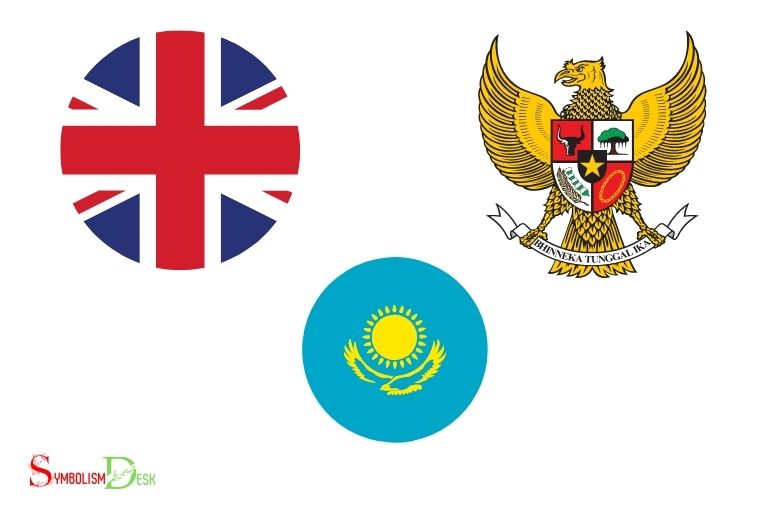What is the Meaning of National Symbols? Values!
National symbols are visual or verbal representations that express the identity, values, and aspirations of a country or nation.
They foster national pride, unity, and a sense of belonging among the citizens.
National symbols are crucial for a country because they encapsulate its culture, history, and ideals.
These symbols are often chosen for their historical significance, natural beauty, or cultural importance, and can be found in various forms such as flags, emblems, anthems, or other representations.
By understanding and respecting national symbols, people connect with their country’s heritage and contribute to the preservation of its ethos.
National symbols contribute to the formation of a collective national identity by providing a shared understanding of a nation’s history, culture, and values.
These symbols serve as a reminder of the struggles and achievements that have shaped the country, and they inspire citizens to work together for the common good.
By recognizing and honoring national symbols, we can foster a sense of unity and respect for our country’s unique heritage.
Overview of National Symbols and Their Meanings
| National Symbol | Country | Meaning |
|---|---|---|
| Bald Eagle | United States | Represents freedom, strength, and independence; a symbol of the nation’s connection with nature and its native heritage |
| Maple Leaf | Canada | Signifies unity, tolerance, and peace; also represents the natural beauty of Canada |
| Union Jack | United Kingdom | Symbolizes the union of England, Scotland, and Ireland |
| Eiffel Tower | France | Represents industrial progress and innovation; a symbol of French national pride and a prominent cultural landmark |
| Tricolour Flag (Black, Red, Yellow) | Germany | Symbolizes national unity, democracy, and freedom; each color represents a different historical period |
| Dragon | China | Symbolizes power, strength, and good fortune; represents the authority of the Chinese emperor and the nation’s rich mythology |
| Kangaroo and Emu | Australia | Represents the unique wildlife of Australia; symbolizes progress as both animals cannot move backwards |
| Taj Mahal | India | Symbolizes love, devotion, and architectural splendor; reflects the rich cultural heritage of India |
| Kiwi | New Zealand | Represents the unique and diverse wildlife of New Zealand; also a nickname for New Zealanders |
| Samba | Brazil | Symbolizes the lively and energetic spirit of Brazilian culture; a popular dance and music style |
| Mount Fuji | Japan | Represents the natural beauty and cultural significance of Japan; a symbol of national pride |
| Samovar | Russia | Symbolizes hospitality, warmth, and the importance of tea-drinking in Russian culture |
Key Takeaway

Five Facts About: National Symbols
Understanding The Concept Of National Symbols
National symbols are an essential aspect of a country’s identity. They represent the values, traditions, culture, and history of the nation.
Understanding the concept of national symbols is crucial to comprehend the significance of their use. In this blog post, we will delve into the definition and importance of national symbols.
Definition Of National Symbols
National symbols are representations of a country’s identity, often visual or symbolic in nature. These symbols are usually chosen to represent the memory of historical events, struggles, and victories.
National symbols can be a figure or an object, a song or anthem, a flag, or a national emblem.
Their purpose is to unite the people of a country, create a sense of belonging and patriotism, and promote cultural awareness.
Here are some examples of national symbols:
- National flag
- National anthem
- National emblem
- National animal
- National bird
- National flower
- National tree
Importance Of National Symbols
National symbols have significant importance in a country’s culture. They are a reflection of a country’s identity, sovereignty, and independence.
Nurturing respect for national symbols helps to promote respect for national unity and diversity. Hence, understanding the importance of national symbols is vital.
Here are the reasons why national symbols are important:
- Unites the citizens of a country
- Preserves the country’s heritage and culture
- Promotes cultural awareness and knowledge
- Fosters a sense of belonging and identity
- Helps create a positive image of the country
National symbols play an essential role in shaping a country’s identity. It is the duty of every citizen to respect and honor these symbols.
Failure to promote national symbols can lead to the loss of identity and alienation of its citizens.
Therefore, it is crucial to promote the use of national symbols and understand their significance.
Types Of National Symbols
National symbols represent the cultural heritage and history of a country. These symbols evoke patriotism and a sense of belongingness among citizens.
There are different types of national symbols, including the flag, emblem, national anthem, animal, flower, and coat of arms.
Let’s have a closer look at each of them.
Flag
The national flag represents a country’s identity and is a symbol of national unity.
Here are some key points about the flag:
- The flag’s colors and design often have cultural and historical significance.
- It is a sign of respect to fly the national flag on significant days such as independence day or remembrance day.
- It is forbidden to mistreat, deface, or destroy the national flag.
Emblem
The national emblem is often used on official documents, seals, and passports. It represents a country’s values and beliefs.
Here are some key points about the emblem:
- The emblem may feature symbols such as mountains, animals, or religious motifs.
- It is often used on government buildings and official documents.
- It represents a country’s sovereignty and national values.
National Anthem
A national anthem is a patriotic song that symbolizes a country’s heritage and values. It is played on significant occasions such as official ceremonies and sporting events.
Here are some key points about national anthems:
- National anthems often reflect a country’s history and cultural heritage.
- They can evoke strong emotions and national pride among citizens.
- It is a sign of respect to stand when the national anthem is played.
Animal
National animals are often chosen based on their cultural or historical significance. They can also symbolize a country’s values or beliefs.
Here are some key points about national animals:
- National animals can be real or mythical creatures.
- They are often depicted on official documents or coins.
- They can represent a country’s wildlife conservation efforts.
Flower
Each country has its national flower, which often represents its cultural heritage and importance.
Here are some key points about national flowers:
- National flowers are often used in official ceremonies and celebrations.
- They can also represent a country’s traditions and values.
- National flowers are often chosen for their beauty or cultural significance.
Coat Of Arms
A coat of arms is a heraldic design that represents a country’s sovereignty and identity. It often features symbols such as animals, plants, or crowns.
Here are some key points about coat of arms:
- It is often featured on documents and flags.
- It represents a country’s history, values, and sovereignty.
- The coat of arms design may differ for different governmental institutions.
National symbols play a vital role in a country’s identity and history. Each symbol represents important aspects of a country’s culture, values, and traditions.
By understanding the significance of these symbols, citizens can show respect and pride for their country.
National Pride And Identity
National symbols such as the flag, the coat of arms, the anthem, or the currency are crucial in identifying a country.
These symbols give a clear indication of the nation’s identity and heritage.
In this section, we will be discussing how national symbols have evolved to represent a country’s identity and the significance of these symbols as a source of strength and unity.
How National Symbols Represent The Country’S Identity
National symbols represent more than just a country’s heritage; they give an insight into a nation’s identity.
Here are some of the ways these symbols represent a country’s identity:
- Historical significance: National symbols represent a country’s history, their struggles and triumphs. For instance, a flag can represent the struggles of individuals who fought for their country’s independence.
- Cultural symbolism: National symbols also represent a country’s culture and customs. The coat of arms is one such example; it embodies the customs, traditions, and beliefs of the nation.
- Sovereignty: National symbols represent a country’s sovereignty and freedom. The currency symbol represents the independence of a nation.
National Symbols As A Source Of Strength And Unity
National symbols not only represent the country’s identity but also serve as a source of strength and unity among its citizens.
Here are some of the ways national symbols can unify a nation:
- Patriotism: National symbols instill patriotism and national pride among people.
- Civic responsibility: These symbols inspire citizens to uphold their civic responsibilities, and they instill a sense of loyalty and commitment towards their nation.
- Shared purpose: National symbols are a source of shared purpose for people of various backgrounds. Immigrants who identify with these symbols soon develop an affinity for their adopted country.
National symbols are an essential aspect of a country’s identity.
They embody the country’s history, culture, and sovereignty, and they instill a sense of national pride and unity among its citizens.
They help people recognize themselves as part of something bigger than themselves and inspire them to work together for the betterment of their country.
Historical Significance
National symbols are an essential part of any country’s identity, reflecting its unique history, culture, and values.
These symbols often serve as reminders of significant events, people, or places and help to unite the country’s diverse population.
In this blog post, we will explore the meaning of national symbols, concentrating on their historical significance.
The Role Of National Symbols In History
National symbols provide a visual representation of a country’s identity and often have a deep-rooted history.
Here are some key points to understand the significance of national symbols in the past:
- National symbols helped to create a sense of unity among different regions or groups of people within a country.
- Historical events such as wars or independence movements often create new national symbols that represent the struggle and sacrifices of the people.
- National symbols can inspire pride and patriotism in citizens, promoting social cohesion and a shared sense of identity.
- Through the use of national symbols, countries can also uphold and promote their values, such as freedom, justice, and equality.
Historical Figures As National Symbols
Some of the most recognizable national symbols are historical figures who have significantly impacted a country’s past.
Here are some crucial points to understand regarding historical figures as national symbols:
- Historical figures serve as a reminder of a country’s past, including the challenges it has faced and overcome.
- These figures are often chosen based on their contributions to a nation’s development, such as founding fathers, heroic military leaders, or intellectual icons.
- National symbols that are historical figures help to inspire a sense of reverence or respect for the past, promoting a deeper understanding of a country’s history.
- Many national symbols continue to evoke strong emotions and serve as a reminder of significant events, such as abraham lincoln, the washington monument, and the statue of liberty.
National symbols are an essential aspect of a country’s identity and help to promote social cohesion and a shared sense of pride.
Historical figures and events play a crucial role in shaping national symbols, creating a visual representation of a country’s past, values, and ideals.
International Relations
National symbols are the visible aspects of national identity that represent a country’s history, culture, and values.
Every nation has its own national symbols, such as the united states of america’s flag, the bald eagle, and the statue of liberty.
These symbols have a significant role in international relations, as they can speak volumes about a country’s values and ideals.
In this blog post, we will explore how national symbols impact international relations and how they reflect a nation’s values and ideals.
The Role Of National Symbols In Diplomacy
Diplomacy is the art and science of international relations, involving the negotiation and management of international agreements between countries.
National symbols are an integral part of diplomacy, as they serve as a window into a country’s culture and values. They can reflect the country’s history, cultural diversity, and social values.
Here are some ways in which national symbols play a role in diplomacy:
- National symbols create a sense of national pride among citizens, which can be projected onto international platforms, aiding in diplomacy and communication with other countries.
- National symbols help to establish a country’s identity in the international community, creating a positive image and reputation.
- They can be used as a tool to promote tourism and attract foreigners to a country.
- National symbols can also be used to establish a sense of solidarity and unity with other countries through shared interests and values.
National Symbols As A Reflection Of National Values And Ideals
National symbols can also reflect a country’s values and ideals. These symbols can represent the noble ideals and aspirations of a nation, including its political, social, and cultural values.
A country’s national symbols can draw attention to its unique characteristics, highlighting its distinctiveness and cultural richness.
Here are some examples of national symbols that reflect a country’s values and ideals:
- The bald eagle is the national symbol of the united states of america, symbolizing power, freedom, and strength.
- The maple leaf is the national symbol of canada, representing the country’s natural beauty and cultural diversity.
- The lotus flower is the national symbol of india, symbolizing enlightenment, purity, and spirituality.
- The kangaroo is the national symbol of australia, representing the country’s unique wildlife and culture.
National symbols play a vital role in international relations as they can reflect a nation’s values and ideals.
They serve as a tool for creating a positive image of a country, promoting unity and solidarity, and projecting national identity onto the international community.
National symbols transcend language barriers and aid in diplomacy, making them an integral part of international relations.
Cultural Symbols Beyond Borders
National symbols represent the cultural and historical identity of a country. These symbols are not just limited to borders, as they also represent a particular culture, heritage, and values, which in turn offer a sense of belonging and pride to the natives.
Similarities Between National Symbols Across Cultures
National symbols tend to reflect certain similarities across diverse cultures.
Some of the common characteristics include:
- Design elements: It’s not uncommon to find the use of similar design elements, such as the sun, stars, and stripes, in various national symbols.
- Historical significance: Many national symbols also tend to have historical references or significance. For instance, the eagle is a symbol of strength, freedom, and independence in the united states, mexico, and egypt.
- Cultural significance: National symbols typically illustrate the cultural heritage of a country, as seen in the use of the eagle as the national bird in multiple countries. Similarly, the depiction of mythological creatures like dragons, lions, and tigers reflects a country’s ingrained cultural values and beliefs.
Unique Symbolism In Different Cultures
While national symbols may share similarities across nations, they also have distinctive meanings, based on a country’s culture, geography, and history.
- Animals: Some countries use an animal as a national symbol, which is indicative of its unique wildlife. For instance, the kangaroo is a recognizable national symbol of australia, and the panda is a symbol of peace and friendship in china.
- Plants: National symbols also include plant-based elements that reflect a country’s geography, climate, and vegetation. For example, the maple leaf is a symbol of canada’s vast forested areas, while the lotus is representative of purity and enlightenment in india.
- Colors: The colors of a national symbol also hold significant meaning, like the black, red, and yellow connotations of the aboriginal flag in australia or the red, white, and blue hues of the united kingdom flag.
National symbols offer a glimpse into a country’s rich cultural heritage and legacy, and it is crucial to understand their significance fully.
While some similarities and common characteristics can be found, every country’s national symbol remains unique, encapsulating the essence of its people, beliefs, values, and traditions.
Changing Symbolism
National symbols are an essential part of any country’s identity. They are the representations of a nation’s values, culture, and history, with the aim of fostering patriotism and a sense of belonging among its citizens.
However, as countries evolve, their values, culture, and history change, resulting in changes in the symbolism of their national symbols.
In this blog post, we will explore the concept of changing symbolism and what happens when symbols no longer represent values. Let’s dive in.
Evolving Meanings Of Symbols Over Time
National symbols such as flags, anthems, and emblems, have been in existence for centuries. Over time, the meanings associated with these symbols have evolved due to several factors, including social, political, and cultural changes.
Here are some key points to consider.
- Symbols are not static, they evolve over time: National symbols are not set in stone, but rather, they are reflections of a country’s social, political, and cultural evolution. For example, the american flag has had 27 different designs since its inception. Each change was influenced by the nation’s values, culture, and political dynamics.
- Evolving meanings may affect national identity: As the meaning of national symbols evolves, some people may feel disconnected from them. This phenomenon can lead to a weakening of national identity. For example, in canada, the national hockey team’s jersey was once a prominent symbol of canadian patriotism. However, as the sport became increasingly globalized, the jersey’s meaning shifted, and some canadians no longer associate it with their national identity.
What Happens When Symbols No Longer Represent Values?
When a national symbol no longer represents a country’s values, it can undermine the very essence of that symbol’s existence.
Here are some key points to bear in mind.
- A loss of meaning can lead to a loss of respect: When a symbol no longer represents a nation’s values and ideals, it loses its power to inspire national pride and respect. For example, the confederate flag, which was once a symbol of southern pride, has become increasingly divisive, and many americans no longer respect it as a symbol of their nation’s heritage.
- Changing symbols can be contentious: Changing or retiring a national symbol can be a challenging process, as it often involves negotiating complex and deeply rooted cultural and political values. For example, in new zealand, there has been a long-standing debate over changing the national flag, with some arguing that the current flag does not represent their nation’s identity.
The meanings of national symbols are not fixed but rather are reflections of a country’s evolving values and culture.
Changes in symbolism can have a profound impact on national identity and can be contentious when they no longer represent a nation’s values.
Understanding how changing symbols influence a nation’s identity is crucial to maintaining a cohesive national identity.
Symbolism In Politics
Symbols have always held a special place in human societies. From ancient times, symbols have been used to express ideas, concepts, and emotions. In modern times, symbols have become an integral part of our national identity.
Every country has its own set of national symbols that represent its history, culture, and aspirations.
In this blog post, we’ll explore the meaning of national symbols and how they are used in politics. So, let’s get started!
Political Uses Of National Symbols
National symbols play a crucial role in politics. They are often used by politicians to evoke patriotism, national pride, and a sense of unity among citizens.
Here are some of the political uses of national symbols:
- National symbols are often used in political speeches to appeal to the emotions of the audience. For example, a politician may use the national flag to remind people of the sacrifices made by their ancestors to achieve independence.
- National symbols are also used to represent political ideologies. For example, in the united states, the bald eagle is often used as a symbol of freedom and democracy.
- National symbols are used to commemorate important events in a country’s history. For instance, in india, the national emblem features four lions, which represent the lion capital of ashoka, an ancient indian sculpture that was adopted as the national emblem after india gained independence in 1947.
National Symbols And Political Controversies
However, the use of national symbols in politics is not always straightforward. National symbols can also become a source of controversy and division in society.
Here are some examples:
- In the united states, the confederate flag has become a highly controversial symbol due to its association with slavery and racism. Some people see it as a symbol of southern heritage, while others view it as a reminder of the country’s dark past.
- In taiwan, the use of the national flag has become a source of political tension due to the country’s ambiguous political status. The flag is often used by supporters of taiwanese independence, but it is also seen as a symbol of chinese sovereignty by those who support reunification with china.
- In zimbabwe, the national flag has become a symbol of protest against the government. In 2016, a protest movement called #thisflag emerged, which used the national flag as a symbol of unity and resistance against the government’s corruption and economic mismanagement.
National symbols are deeply ingrained in the political and cultural fabric of every country. They can evoke powerful emotions and convey complex ideas, but they can also become a source of controversy and division.
As such, it is important to approach national symbols with sensitivity and respect, and to recognize their full range of meanings and associations.
Historical Issues And National Symbols
What is the meaning of national symbols: historical issues and national symbols
National symbols play a crucial role in representing a country’s heritage and culture. These symbols, such as flags, anthems, and seals, embody a country’s identity and values.
However, national symbols can also be a subject of controversy, especially when historical figures with conflicting legacies are involved.
We delve into the debate over symbolic representations of national history.
National Symbols Representing Controversial Historical Figures
Some national symbols are associated with historical figures who evoke conflicting emotions in modern society.
For example:
- Robert e. lee is considered a hero by some, but others consider him a traitor to the union. The use of confederate flags and statues of lee’s has sparked debates about the legitimacy of honoring his legacy as a national symbol.
- Christopher columbus is celebrated as the discoverer of america, but his treatment of indigenous people raises questions about whether he deserves to be an honored national figure.
The Debate Over Symbolic Representations Of Slavery
The slave trade played a significant role in many countries’ histories, and it is a subject of debate whether slavery should be recognized in national symbols.
Here are some examples:
- The confederate flag, which was used during the american civil war, is associated with pro-slavery sentiments. Its continued use in some states has fueled arguments about whether it is an appropriate symbol to represent those areas.
- In canada, the canadian flag has a controversial history that connects it to the indian residential schools. The discovery of unmarked graves at such institutions has inspired a call to redesign the national flag to remove the emblem associated with the schools.
- The dutch national flag is also an issue that is the product of the trans-atlantic slave trade, and the meaning of the relationship between the flag and slavery has provoked public debate.
- The union jack, britain’s national flag, is associated with its colonial history and raises questions about how national symbols can reflect a country’s colonial past.
National symbols are steeped in historical significance and national pride. However, their meaning and use can be contentious.
It is crucial to acknowledge the complexities of history, and it is essential to continue the necessary dialogue around these national symbols.
How Do Adinkra Symbols Reflect Cultural Values?
Adinkra symbol meanings embody the cultural values of the Akan people in West Africa. These symbols, rich in history and tradition, serve as visual representations of principles such as wisdom, courage, and unity. Each adinkra symbol holds a specific significance, allowing individuals to communicate and preserve their cultural heritage through the power of visual language.
FAQ About What Is The Meaning Of National Symbols
What Are National Symbols?
National symbols represent a country’s identity, history, culture and values. These can be flags, songs, emblems, animals, and more.
Why Are National Symbols Important?
National symbols instill a sense of patriotism, unity, and pride among citizens. They help create a unique national identity and history.
What Is The Significance Of The National Flag?
The national flag represents the country’s sovereignty, unity, and pride. Each color and symbol has its own meaning and signifies important national values.
What Is The Role Of National Anthem?
The national anthem is a symbol of a country’s pride, identity, and history. It is played at important events and occasions.
How Were National Symbols Chosen?
National symbols are often chosen based on their historical and cultural significance and reflect the values of the country. They are chosen by governments or citizens.
Conclusion
The national symbols of a country are the representations of its identity, culture, and history. From the flag to the national anthem, every symbol signifies a unique aspect of a country.
It serves as a reminder of the past, the present, and the future.
Furthermore, these symbols foster a sense of pride and patriotism within the citizens of a nation. They help to unify the nation and celebrate its diversity. This shared sense of identity brings people together, encouraging them to embrace their collective heritage while respecting individual differences. For example, understanding American Indian symbol meanings can deepen appreciation for the rich cultural traditions of Indigenous communities, which are integral to the nation’s history. By honoring such symbols, society can promote inclusivity and ensure that diverse voices are recognized and celebrated.
Understanding the meaning of national symbols is crucial, as it helps people to respect and appreciate the cultural values that define a nation.
National symbols are not just about the past; they have a deeper meaning that transcends time.
They are a testament to the values that a country espouses and the virtues that it cherishes. Every country has its own unique set of national symbols that define its identity.
National symbols are a powerful way for countries to represent themselves to the rest of the world and celebrate their unique heritage.






